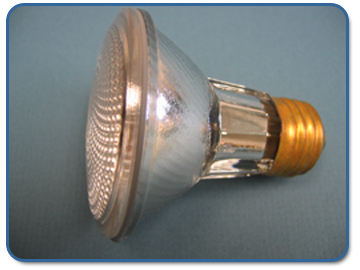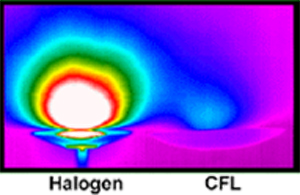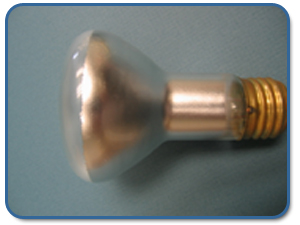There are five basic types of lighting:
- Incandescent
- Fluorescent
- High-intensity discharge
- LED
Incandescent Bulbs
Thomas Alva Edison invented the incandescent light bulb with reasonable life. Lewis Latimer has perfected it with the use of carbon filament.
The incandescent bulb consists of a sealed glass bulb with a filament inside. When electricity is passed through the filament, the filament gets hot. Depending on the temperature of the filament, radiation is emitted from the filament.
The filament's temperature is very high, generally over 2,000º C, or 3,600º F. In a "standard" 60-, 75-, or 100-Watt bulb, the filament temperature is roughly 2,550º C, or roughly 4,600º F. At high temperatures like this, the thermal radiation from the filament includes a significant amount of visible light.
This principle of obtaining light from heat is called ‘incandescence.” At this high temperature of 2,000º C, about 5 percent of the electrical energy converts into visible light and the rest of it is emitted as heat or infrared radiation.
Instructions : Press play to see how an incandescent light bulb works. (Note: The animation has no audio.)
How an Incandescent Light Bulb Works
In an incandescent light bulb, electricity travels up and through the filament, causing it to heat up and glow brightly. To prevent the filament from combusting, all of the oxygen is removed from the bulb.
Let’s now look at several different types of incandescent bulbs.
Standard incandescent bulbs
Standard incandescent bulbs are most common and yet are the most inefficient. Larger wattage bulbs have a higher efficacy (more lumens per Watt) than smaller wattage bulbs.
Instructions: Click the “graph” button below to create a graph comparing Watts and efficiency, and then answer the question below.
Comparison of Watts and Efficiency for an Incandescent Bulb
The table below compares the number of Watts of a light bulb to its efficiency (lumens per Watt).
| Watts (power) | 25 | 40 | 60 | 75 | 100 | 150 |
|---|---|---|---|---|---|---|
| Efficiency (lumens per Watt) | 8 | 12 | 14 | 15 | 17 | 19 |
Based on this data, it is clear that as the number of Watts increase, so does the efficiency.
Tungsten halogen bulbs
Tungsten halogen is an incandescent lamp with gases from the halogen family sealed inside the bulb and an inner coating that reflects heat back to the filament. It has similar light output to a regular incandescent bulb, but with less power. Halogens in the gas filling reduce the material losses of the filament caused by evaporation and increase the performance of the lamp.

Tubular tungsten-halogen bulbs
Tubular tungsten-halogen bulbs are commonly used in “torchiere” floor lamps, which reflect light off of the ceiling, providing more diffused and suitable general lighting.
Although these provide better energy efficiency than the standard A-type bulb, these lamps consume significant amounts of energy (typically drawing 300 to 600 W) and become very hot (a 300-W tubular tungsten-halogen bulb reaches a temperature of about 2600° C compared to about 600° C for a compact fluorescent bulb). Because Tungsten-halogen lamps operate at very high temperatures (high enough to literally fry eggs), they should not be used in fixtures that have paper- or cellulose-lined sockets.
Halogen bulbs
A halogen bulb is often 10 to 20 percent more efficient than an ordinary incandescent bulb of similar voltage, wattage, and life expectancy. Halogen bulbs may also have two to three times as long a lifetime as ordinary bulbs. How much the lifetime and efficiency are improved depends largely on whether a premium fill gas (usually krypton, sometimes xenon) or argon is used. The image below shows a picture taken with an Infrared camera comparing the heat produced by a halogen and a compact fluorescent light bulb. The red and white color zones are extremely hot, and the blue zones are cooler.

Reflector Lamps
Reflector Lamps - Light waves from a bulb spread in all directions. The light that goes toward the back is not useful when the light is most needed in the front. Reflector lamps (Type R) are designed to spread light over specific areas.
Reflector lamps have silver coating on the sides, like any mirror, and therefore all the light waves passing through the sides or the back are reflected to the front. Therefore, they are called reflector lamps and are also called floodlighting, spotlighting, and down lighting bulbs.
Instructions: Click the buttons below to see the difference between a regular and reflective lamp light bulb:
(Note: The animations have no audio.)
Parabolic aluminized reflector (PAR) lamps
Parabolic aluminized reflector (PAR) lamps (shown in the image below) are also available with halogen technology to operate at 120 volts. A standard 150-W incandescent spotlight can be replaced with a lower wattage halogen lamp, reducing electricity consumption by up to 40 percent.

